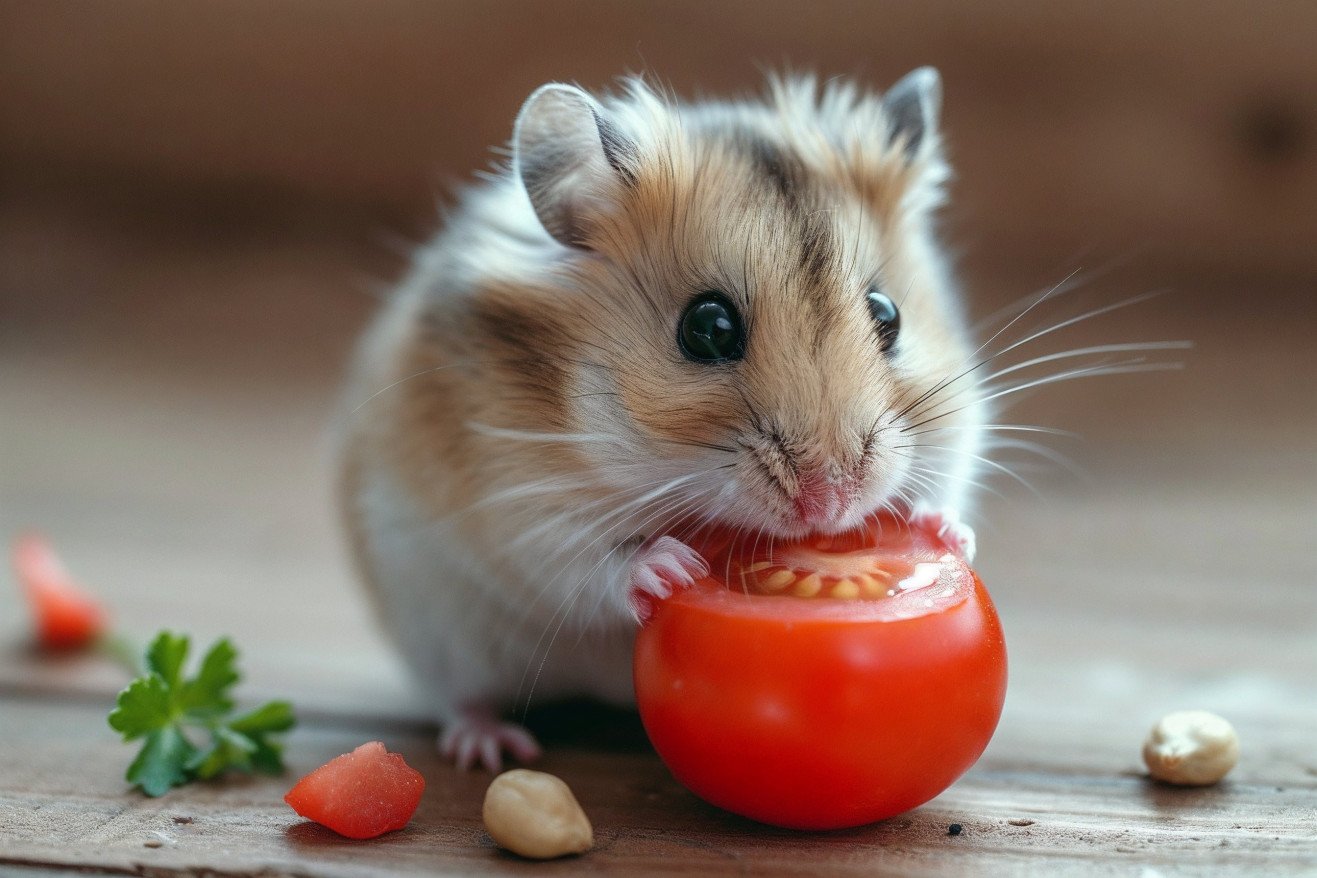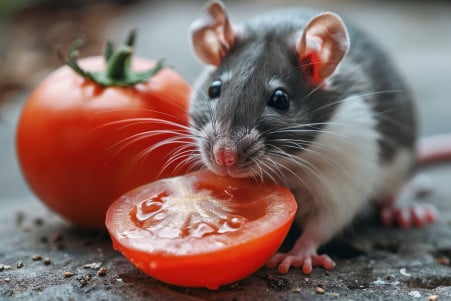Can Hamsters Eat Tomatoes? Safe Snacking Guide for Your Pet
31 January 2024

If you’re a hamster owner, you may have asked yourself if you can share your tomatoes with your furry friend. The good news is that hamsters can eat ripe tomatoes, but there are some important things to keep in mind.
For example, while the fruit is safe, the leaves and stems of the tomato plant are poisonous. You can give your hamster a small piece of tomato about the size of a cherry tomato once or twice a week, but make sure it’s been cut into pieces and washed thoroughly.
This article will review evidence from veterinary science, nutrition, and general care recommendations to give you a complete picture of what hamsters need in their diet. We’ll cover how to include tomatoes and the nutrients they contain in your hamster’s diet, discuss the potential risks and benefits, and talk about how to make sure you’re doing it right.
By the time you finish this article, you’ll know exactly how tomatoes can impact your hamster’s well-being.
Can hamsters eat tomatoes?
How to Balance Tomatoes in a Hamster’s Diet
A well-balanced diet that meets a hamster’s nutritional needs is important for their overall health. According to NCBI Bookshelf, a hamster’s diet should be tailored to meet their energy requirements and include essential fatty acids, vitamins, and minerals.
Tomatoes, which are a good source of vitamin C, potassium, folate, and the antioxidant lycopene, can be a healthy addition to a hamster’s diet. As PetMD explains, a hamster’s staple diet should be made up of pellets, but it can be supplemented with vegetables and fruits like tomatoes to help ensure that the hamster doesn’t develop a nutritional deficiency.
Tomatoes are a good source of the nutrients that hamsters need, especially water, which is important for hydration. However, it’s important to feed tomatoes in moderation. Healthline warns that tomatoes are high in water and can cause diarrhea if fed in excess. It’s also important to limit the amount of natural sugars that hamsters consume to help prevent diabetes and obesity.
If fed in the right amounts and frequency, ripe tomatoes can be a healthy addition to a hamster’s diet. A small piece the size of a cherry tomato, fed once or twice a week, can help ensure that the hamster’s diet is well-rounded without overloading it.
It’s important to make sure that the tomato is ripe, as the green parts of the plant are toxic. This cautious approach to feeding tomatoes to hamsters is important to help ensure that their nutritional needs are met without upsetting their sensitive digestive systems.
Following the Path of a Hamster’s Digestive System
The digestive system of a hamster is a highly specialized system that has evolved to accommodate the animal’s omnivorous diet. According to Zooplus Magazine, hamsters have two stomachs that are connected: the forestomach, which is used for storage, and the glandular stomach, which is where the digestive process begins. This system is well-suited to breaking down grains and seeds, which are a major part of their diet and are rich in plant-based nutrients.
However, it’s important to note that when it comes to fruits like tomatoes, hamsters can have digestive issues if they are introduced to these foods too quickly. This is because the hamster’s digestive system, including its relatively small appendix, which is a pouch that contains bacteria that helps break down fibrous plant matter, needs time to adjust to the new food without causing an imbalance.
If hamsters are fed an inappropriate diet or their diet is changed too quickly, they can develop problems like diarrhea, which is caused by the large intestine reabsorbing water from the food that has been digested.
The UC Davis School of Veterinary Medicine’s guidelines for care notes that hamsters have a sensitive digestive system that doesn’t handle high-sugar foods well, so it’s important to make sure that sweet foods like tomatoes are fed in moderation.
This is where the importance of gradually and carefully introducing new foods comes in, as this will help ensure that hamsters can eat tomatoes and get the nutritional benefits without experiencing digestive issues.
Knowing the Dangers: Poisonous Foods for Hamsters
Hamsters, like many other small animals, are curious creatures that love to taste a wide variety of plants, but not all plants are safe for them to eat. According to a post by TinyPetTales, some common indoor and outdoor plants can be extremely poisonous to hamsters, and the green parts of tomato plants, including the leaves and stems, are a perfect example.
Even small amounts of the toxic alkaloid solanine found in these parts can be toxic to hamsters.
Dr. Cayla Iske explains that nightshade, hydrangea, lilies, and yew are other examples of common plants that are poisonous to hamsters. Tannins, phenols, and cyanide are some of the compounds found in these plants that can cause severe illness and even death in hamsters. Signs of toxicity in hamsters can range from mild symptoms like lethargy and loss of appetite to more severe symptoms like respiratory failure and seizures.
If you think your hamster has ingested something toxic, it’s important to get them to a vet right away since hamsters can’t vomit and therefore can’t get rid of ingested toxins. To avoid toxicity, make sure that all of the plants that your hamster can access are non-toxic and keep an eye on your pet’s surroundings for any potential dangers.
Always make sure to think about the potential toxicity of tomatoes and other new foods before you introduce them to your hamster to make sure that they’ll be safe and healthy while they enjoy their snacks.
Allergies in Hamsters: Watch Out for Tomatoes
Although allergies in hamsters are rare, it is important for pet parents to be mindful of potential allergic reactions when feeding their pets new foods like tomatoes. According to a wikiHow article, signs of a possible allergic reaction in hamsters can include constant scratching, hair loss, sneezing, and swollen feet. If you notice any of these symptoms after feeding your hamster tomatoes, it is important to consider the possibility of an allergic reaction.
To help prevent allergies, make sure to introduce tomatoes and other new foods to your hamster slowly. This can mean starting with a small piece and keeping a close eye on your pet for any changes in behavior or physical symptoms.
If your hamster does have an allergic reaction, PetHelpful advises removing the potential allergen from their diet and contacting a vet if the symptoms continue so that your pet can receive the proper care.
Make sure to keep a close eye on your hamster after you introduce a new food into their diet. An article on Mom.com stresses the importance of watching your hamster for any signs of an allergic reaction in the days after you give them tomatoes. This way, you can make sure that you catch any potential issues early and take care of them quickly to ensure that your pet stays healthy and happy.
Feeding Your Hamster Healthy Snacks
When feeding your hamster tomatoes and other fresh foods, it’s important to do so in a way that prioritizes their health. Ontario Hamster Club notes that new foods, including tomatoes, should be fed in small amounts—about the size of your hamster’s ear—and introduced gradually. This way, you can make sure your hamster isn’t having a negative reaction to the new food and that they don’t experience any digestive issues.
When feeding your hamster tomatoes, make sure to wash the fruit thoroughly to remove any pesticides and cut a small piece about the size of a cherry to avoid overfeeding. Make sure to remove all the seeds and any green parts from the tomato, as these can be toxic.
While a healthy hamster diet can include a variety of fruits and vegetables, according to the RSPCA, these should only be fed as supplements to their regular diet, not as replacements. This means that treats like tomatoes should be fed sparingly so that your hamster is still getting most of their nutrition from a diet of specially formulated hamster pellets and a seed mix.
For more specific dietary recommendations, especially for hamsters with special dietary needs, Burgess Pet Care recommends talking to a vet. This way, you can make sure that your hamster’s diet is meeting all of their nutritional needs while also being enjoyable.
In Summary: Tomatoes and Your Hamster’s Diet
In summary, ripe tomatoes can be a healthy snack for your hamster as long as they are fed in moderation. Tomatoes are full of important nutrients like vitamin C and antioxidants that can help support your hamster’s overall health. That said, it’s important to make sure you’re not overfeeding your hamster tomatoes, and that you’re sticking to the cherry-sized portion to avoid any digestive or health issues.
It’s important to make sure you’re feeding your hamster tomatoes in moderation and that you’re watching for potential negative side effects, including diarrhea due to the fruit’s high water content and toxicity due to the plant’s leaves and stems. Always make sure you’re feeding your hamster ripe tomatoes and that you’re removing the seeds and stems before offering them to your pet.
Being a responsible pet owner means making sure you’re making informed decisions about your hamster’s diet. This means making sure you’re meeting their nutritional needs while also allowing them to enjoy a variety of foods in a way that’s safe for their small bodies. By following these tips, you can ensure that you’re providing your pet with not just nutrition but also the care and attention they need and deserve.


